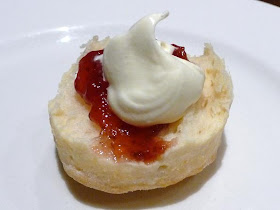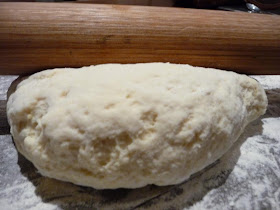
Flour. Butter. Milk. Jam. Cream.
No need to complicate things. No need to buy a packet of biscuits in which the packaging probably cost more than the contents, and probably has fewer unappetising additives. No need to fuss for hours, turning out the most delicately shaped and flavoured colourful tiny petits fours. No need to worry about whether the sponge cake will rise or if the cheesecake will set.
Nothing compares to sitting down at the kitchen table and enjoying a mug of tea (not a cup, not a pot, a mug, preferably with tea-bag still in) and having a good chat and a hot, slightly misshapen scone. No high-tea or trendy cafe can ever replace the gentle satisfaction of doughy steam and flour streaked hair. The comfort of not caring, and just enjoying.
The perfect scone is light and fluffy, without a golden blush on the top. Less than ten minutes to get it into the oven and less than ten minutes in the oven. Unpretentious.
Best served with what is generically known as ‘little-old-lady-church-jam’ which can be procured from any country market or church fete, usually sold in jars of varying sizes that used to contain tomato paste or pickles, topped with gingham-checked circles of cloth, with each different coloured mop-top indicated a different flavour of jam (flavours will include passionfruit and tomato jam, grapefruit marmalade, peach and walnut jam, carrot and lemon marmalade and cherry chutney). Cream, whipped, is not optional.

Simple scones, no fuss
This recipe is remembered from the now fallen-apart Commonsense Cookery Book. The Book is still in print, although updated. Mine was published in the 50s.
2 cups self raising flour
50 gm butter, cold, diced
1 cup milk (curdled with 1 tbsp lemon juice, optional)
Preheat oven to hot – about 220ºc. Line a baking slide with greaseproof paper.
Sift flour into a bowl. Toss in cubed butter. Rub through the butter. This mean very lightly with your finger tips crush the butter cubes into the flour. Do not use your whole palm – you want the butter to be crumbled into the flour but not melted. Rub in under the mixture resembles very fine bread crumbs. Alternatively, put the flour and butter into a food processor and pulse until fine crumbs form.
Make a well and pour in three quarters of the milk. Mix together with a butter knife until a loose ball of dough forms – adding more milk as required.
Turn out onto a board or bench lightly floured (with self raising flour) and knead lightly until a smoothish dough forms.
Roll with a rolling pin until about 2cm thick. Cut with a scone cutter (do not twist the cutter as you cut – this will seal the scone edges and they won’t rise as well). (re-knead any dough after you have cut and roll and cut again, until the scone dough is used up)
Place the scones on to the baking slide, brush the tops with a little milk.
Bake in the hot oven for about 10 minutes, until puffed up and springy.
Serve immediately with whipped cream and your favourite jam.
No need to complicate things. No need to buy a packet of biscuits in which the packaging probably cost more than the contents, and probably has fewer unappetising additives. No need to fuss for hours, turning out the most delicately shaped and flavoured colourful tiny petits fours. No need to worry about whether the sponge cake will rise or if the cheesecake will set.
Nothing compares to sitting down at the kitchen table and enjoying a mug of tea (not a cup, not a pot, a mug, preferably with tea-bag still in) and having a good chat and a hot, slightly misshapen scone. No high-tea or trendy cafe can ever replace the gentle satisfaction of doughy steam and flour streaked hair. The comfort of not caring, and just enjoying.
The perfect scone is light and fluffy, without a golden blush on the top. Less than ten minutes to get it into the oven and less than ten minutes in the oven. Unpretentious.
Best served with what is generically known as ‘little-old-lady-church-jam’ which can be procured from any country market or church fete, usually sold in jars of varying sizes that used to contain tomato paste or pickles, topped with gingham-checked circles of cloth, with each different coloured mop-top indicated a different flavour of jam (flavours will include passionfruit and tomato jam, grapefruit marmalade, peach and walnut jam, carrot and lemon marmalade and cherry chutney). Cream, whipped, is not optional.

Simple scones, no fuss
This recipe is remembered from the now fallen-apart Commonsense Cookery Book. The Book is still in print, although updated. Mine was published in the 50s.
2 cups self raising flour
50 gm butter, cold, diced
1 cup milk (curdled with 1 tbsp lemon juice, optional)
Preheat oven to hot – about 220ºc. Line a baking slide with greaseproof paper.
Sift flour into a bowl. Toss in cubed butter. Rub through the butter. This mean very lightly with your finger tips crush the butter cubes into the flour. Do not use your whole palm – you want the butter to be crumbled into the flour but not melted. Rub in under the mixture resembles very fine bread crumbs. Alternatively, put the flour and butter into a food processor and pulse until fine crumbs form.
Make a well and pour in three quarters of the milk. Mix together with a butter knife until a loose ball of dough forms – adding more milk as required.
Turn out onto a board or bench lightly floured (with self raising flour) and knead lightly until a smoothish dough forms.
Roll with a rolling pin until about 2cm thick. Cut with a scone cutter (do not twist the cutter as you cut – this will seal the scone edges and they won’t rise as well). (re-knead any dough after you have cut and roll and cut again, until the scone dough is used up)
Place the scones on to the baking slide, brush the tops with a little milk.
Bake in the hot oven for about 10 minutes, until puffed up and springy.
Serve immediately with whipped cream and your favourite jam.


No comments:
Post a Comment